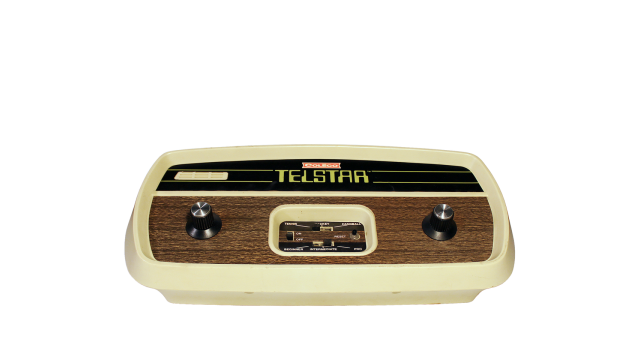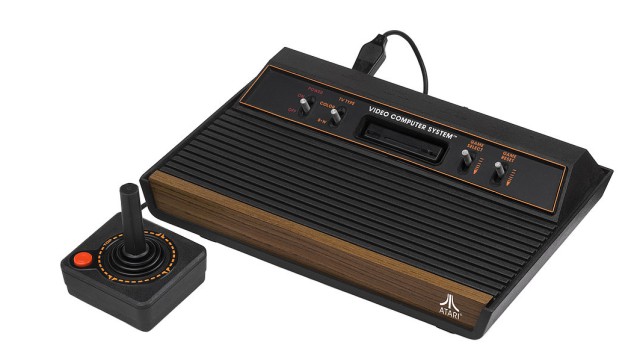
Telstar
Launches: 1976
Generation: 1st
 Telstar technical specifications
Telstar technical specifications
CPU: General Instruments AY-3-8500
Memory: None
 Telstar video specifications
Telstar video specifications
Telstar graphics capabilities.
 Telstar audio specifications
Telstar audio specifications
Telstar sound capabilities.
Audio chip:
Audio mode:
 Controllers of Telstar
Controllers of Telstar
 Telstar games support
Telstar games support
Support:
Telstar games
Games library: 4
Telstar story
The Coleco Telstar represents an early and influential chapter in the history of video game consoles, reflecting the innovation and enthusiasm of the gaming industry during the 1970s. The story of the Telstar is intertwined with the rise of home video gaming and the efforts of Coleco Industries to capitalize on this burgeoning market.
The creation of the Coleco Telstar was driven by Coleco Industries, a company better known for its successful line of plastic and electronic toys. Founded in 1932, Coleco had established itself in the toy industry long before venturing into video games. By the early 1970s, the success of arcade games like Atari’s "Pong" had sparked significant interest in home gaming systems. Coleco, recognizing the potential of this new entertainment medium, decided to enter the market by developing a home video game console. The objective was to produce a system that was both affordable and easy to use, catering to the growing number of families interested in home entertainment.
The development of the Telstar began with Coleco's decision to create a console that could deliver simple yet engaging gameplay. The Telstar was designed as an integrated system with built-in games, a departure from the cartridge-based systems that would later become prevalent. The console utilized analog technology rather than digital, which was common in early video game systems. This approach allowed Coleco to keep production costs low while still delivering a playable gaming experience. The Telstar’s games were essentially variations of the same basic concepts, primarily involving paddle-and-ball mechanics reminiscent of "Pong."
One of the key aspects of the Telstar's development was its simplicity. Unlike more complex systems, the Telstar was designed to be straightforward and easy for consumers to operate. It featured a rotary dial controller, which allowed players to control the on-screen paddles. This controller was simple but effective, providing a basic interface for playing the included games. The Telstar was marketed as a plug-and-play system, which meant that users could start playing immediately without needing to purchase additional hardware or software.
The launch of the Coleco Telstar occurred in 1976, during a period when the video game market was expanding rapidly. The console was introduced with a variety of marketing strategies aimed at capturing the attention of consumers who were eager to bring arcade-style gaming into their homes. Coleco’s promotional efforts highlighted the Telstar’s affordability and ease of use, positioning it as an accessible option for families looking to enjoy video games without a significant financial investment.
At launch, the Coleco Telstar was available in several models, each offering different features and variations of the core gameplay. The original Telstar featured games similar to "Pong," including variations like tennis, hockey, and handball. These games were designed to be engaging and easy to understand, catering to a broad audience. The Telstar’s success was also supported by its attractive price point, which made it an appealing choice for consumers looking for a cost-effective entry into the world of home gaming.
In terms of market reception, the Coleco Telstar achieved notable success, particularly in the context of its time. The console was well-received for its affordability and ease of use, which made it an attractive option for many families. The Telstar’s success was part of a broader trend in the 1970s, where simple, home-based video game systems began to gain popularity as the market for home entertainment expanded.
The Telstar’s success can be attributed to several factors. Its integration of basic games and straightforward controls made it accessible to a wide range of consumers, including those who were new to video gaming. Additionally, the Telstar’s price point was lower than many competing systems, making it an attractive option for families who wanted to experience video gaming without spending a lot of money.
However, the Telstar also faced challenges as the video game market continued to evolve. As the industry progressed, more advanced and feature-rich consoles began to emerge, offering greater complexity and a wider range of games. The Telstar’s simplicity, while initially a strength, eventually became a limitation as consumers’ expectations and preferences shifted toward more sophisticated gaming experiences.
Despite these challenges, the Coleco Telstar remains an important part of video game history. It represents one of the early attempts to bring arcade gaming into the home and played a role in shaping the development of the home console market. The success of the Telstar paved the way for future innovations in gaming technology and demonstrated the growing potential of the home video game industry.
In retrospect, the Coleco Telstar is remembered as a pioneering console that introduced many consumers to the world of home video gaming. Its simple design and affordability made it a popular choice during the early years of the home console market, and its legacy endures as a testament to the early days of video game innovation.
Next Coleco console: ColecoVision
